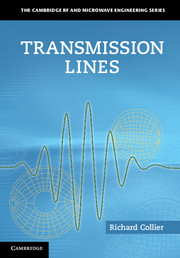8 - Further discussion of photons and other topics
from Part 3 - Transmission lines and photons
Published online by Cambridge University Press: 05 March 2013
Summary
This chapter will complete the discussion about photons on transmission lines. In the first three chapters, the equivalent circuit technique was used to develop many aspects of transmission lines. This involved a one dimensional analysis which has stood the test of time and still produces a useful, although incomplete, picture. However, in the second section, the analysis using electromagnetic waves was given, revealing the three dimensional nature of transmission lines. This showed features that the first section was not able to do; in particular, the velocity and the characteristic impedance of the waves as well as the propagation of higher order modes and the causes of attenuation. The electromagnetic wave approach is outstanding in its accurate prediction of the complex nature of transmission lines. In Chapter 7, a third method was considered using only plane waves travelling at the velocity of light. It was assumed that these plane waves were made up of linearly polarised photons. In this chapter, some more aspects of photons will be considered to see what other properties of transmission lines can be revealed. The use of photons is sufficiently new to be less well established and accepted as the other two approaches to transmission lines used so far. One problem lies in the separation between classical and quantum electrodynamics. The classical theory can be used quite satisfactorily for large numbers of photons. However, if individual photons are being considered, only the quantum theory will describe the phenomena adequately. The full treatment of photons using quantum mechanics is beyond the scope of this book but, where appropriate, the results of such a treatment will be quoted. The other problem lies in the somewhat conflicting theories that currently exist. This chapter should therefore be read with some caution as the picture presented may well change in the near future. Fortunately, the contents of the first seven chapters are sufficiently uncontroversial to not need changing within the lifetime of this book.
- Type
- Chapter
- Information
- Transmission LinesEquivalent Circuits, Electromagnetic Theory, and Photons, pp. 294 - 314Publisher: Cambridge University PressPrint publication year: 2013



